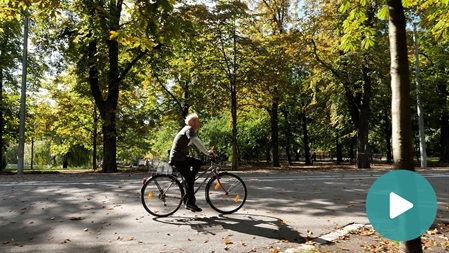Eberhard Jordan: When I think back to the time before I got the valves and could barely make it up the two flights of stairs to my apartment, what I’m doing now feels like a small miracle — a real wow effect for me. Climbing the DC Tower, that was quite a big deal. That building is just massive and incredibly tall. We trained for it intensely for a long time, and during the climb itself, by the time I reached the 40th floor, I knew I had made it.My name is Eberhard Jordan. I am a visual artist, COPD activist, and author — and a valve recipient.
Prim. Dr. Valipour: My name is Arschang Valipour. I’m a pulmonologist and internist at Floridsdorf Clinic in Vienna. I’ve been treating patients with COPD for around 25 years.
Dr. Petrovic: My name is Milos Petrovic. I’m a pulmonologist in Vienna and have had my own practice for three years. In addition, I work in outpatient rehabilitation at Therme Wien Med.
Prim. Dr. Valipour: So, what were the main symptoms of COPD and emphysema before treatment with the valves took place?
Eberhard Jordan: The main symptoms were that I could barely climb stairs anymore — let alone walk behind someone or keep up with them. Carrying groceries — I experienced extreme shortness of breath. When I got agitated, I could hardly breathe. These were the everyday struggles.
Prim. Dr. Valipour: How did you learn about valve therapy for treating emphysema?
Eberhard Jordan: I actually learned about Zephyr® valves indirectly. At the time, I was already considering: what about a transplant? And during all that research, I met a doctor who told me about Zephyr valves and said: “Give it a try — maybe it’ll work.”
Prim. Dr. Valipour: What treatment options are available when COPD has progressed this far?
Dr. Petrovic: Of course, we try every medication, every inhaler available, increasing both strength and dosage. A second key component is rehabilitation. Unfortunately, once we’ve exhausted those options and the patient still doesn’t improve, our hands are tied. Then, we have to consider whether a minimally invasive procedure — like valve implantation — might be appropriate, or even a major surgery. And that would be lung transplantation.
Prim. Dr. Valipour: Valve implantation is a method to improve lung function in people with severe emphysema. You underwent this procedure.
Eberhard Jordan: Yes, though I should say it wasn’t just one valve implantation — I had three attempts. The first time, the results were incredible, very quick, and I was overjoyed. But that success faded quickly. Then we both decided: “Okay, let’s try a second round.” Again, great results — but suddenly it dropped back to the previous level. And then came the third attempt — and that’s been working wonderfully for seven years now.
Prim. Dr. Valipour: There can be various reasons for that. We also talked about it back then. For example, valves can shift or not sit quite as well as they should. In the vast majority of cases, though, it works the first time.What impact did the therapy have on your quality of life?
Eberhard Jordan: Everyday activities became easier because I felt safer, because I had more lung capacity. I was able to train more — and that was personally very important to me.I set myself the challenge: “Okay, Vienna has several towers — and I want to climb those towers, just because I know how hard it is to climb even to the second floor when you have COPD.”And I tell everyone: the DC Tower is not the real measure. The real measure is making it to the second or third floor.
Prim. Dr. Valipour: I think we can both say, as the treating pulmonologists, that Mr. Jordan has truly achieved something remarkable — thanks to consistent medication therapy, valve therapy, and, above all, very consistent training, which made such an achievement possible in the first place.So, what challenges are you planning to take on next, and how are you doing at the moment?
Eberhard Jordan: Right now, I’m feeling very stable, and I’m already looking forward to getting back on my bike and tackling 44 kilometers on the Danube Island. That’s my next challenge.











